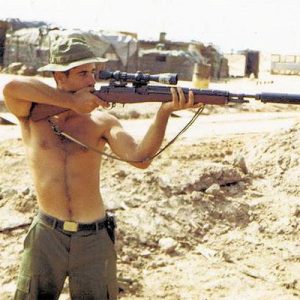calsfoundation@cals.org
Carlos Norman “Gunny” Hathcock II (1942–1999)
Gunnery Sergeant Carlos Norman Hathcock II is believed to have attained the highest number of recorded kills in the history of the United States Marine Corps (USMC). Known to his fellow soldiers as “Gunny,” Hathcock had ninety-three confirmed kills as a sniper during the Vietnam War. Others have had more confirmed kills, but his actual total is estimated to be more than 300. He was also instrumental in establishing the Marine Corps Scout/Sniper School at Quantico, Virginia, and helped plan its syllabus.
Carlos Hathcock was born on May 20, 1942, in North Little Rock (Pulaski County) to Carlos and Agnes Hathcock. He was fond of firearms from an early age, playing with a non-operating war relic Mauser that his father had purchased in Europe and given to him when he was three, and later using a J. C. Higgins .22-caliber, single-shot rifle to hunt for food for his family when he was ten. His father was a railroad worker in North Little Rock and then became a welder in Memphis, Tennessee. After his parents separated, Hathcock was raised by his grandmother in Geyer Springs (Pulaski County). He dropped out of high school when he was fifteen and worked for a Little Rock (Pulaski County) concrete constructor until 1959.
Hathcock enlisted in the USMC in Little Rock on May 20, 1959, his seventeenth birthday, with his mother’s written permission. While at boot camp in San Diego, he qualified at the expert level in marksmanship. In 1962, after being transferred to USMC Air Station at Cherry Point, North Carolina, he set the record on the “A” range by shooting 248 out of a possible 250, a record that remained until the course was retired. In 1965, Hathcock reached the number of points necessary to be designated a Marine Corps Distinguished Sniper, and on August 26, 1965, he won the highly coveted 1,000-Yard National High-Power Rifle Championship, known as the Wimbledon Cup.
Hathcock married Josephine Bryan Winstead on November 10, 1962, in North Carolina. They had one son, Carlos Norman Hathcock III, who also joined the USMC.
Hathcock’s most respected work as a sniper was done during his two tours of service in the Vietnam War. He set the record (since broken) for the longest documented sniper kill—a confirmed kill at 2,500 yards (1.42 miles) with an M2 .50-caliber Browning machine gun. He was also in a five-day engagement that devastated an entire company of Viet Cong soldiers. One of the most disciplined kills he made was accomplished by crawling 1,500 yards across an open field over the course of three sleepless days to take one successful shot at a Viet Cong general. (Skeptics have commented that no Viet Cong general is known to have died of gunshot wounds during the years Hathcock was in Vietnam.)
Perhaps Hathcock’s most legendary kill was when he shot an enemy sniper who was hunting him in order to claim the several-thousand-dollar bounty that the Viet Cong had placed on “White Feather,” a nickname that Hathcock had earned because he wore a small white feather in his cap. The kill was made without ever seeing his enemy; he saw a glint of light in the jungle foliage and gambled on taking the shot. The kill was confirmed, and the enemy’s sniper rifle was found next to the body with the scope hollowed out by the bullet that had traveled its length and entered into the enemy sniper’s eye. This shooting is widely imitated in movies, including The Sniper (1993) and Saving Private Ryan (1998).
Hathcock’s second tour in Vietnam abruptly ended on September 16, 1969, when he was riding an assault vehicle that struck a 500-pound mine near the South Vietnamese village of Que-Son. Despite being covered with flaming gasoline that burned him almost beyond recognition, he returned to the vehicle and rescued seven marines. He refused a recommendation for a Medal of Honor for this heroic act but was awarded a belated Silver Star in 1996. After recovering from the burns, he served for another ten years, training USMC snipers until his forced medical retirement in 1979; he had been diagnosed with multiple sclerosis in 1975.
After battling multiple sclerosis for over twenty-five years, Hathcock died on February 22, 1999. He was survived by his younger brother, Billy Jack. Hathcock is buried at Woodlawn Memorial Gardens in Norfolk, Virginia.
A 1986 biography of Hathcock titled Marine Sniper by Charles Henderson has sold over a half million copies. The USMC award for most outstanding marksman bears the name Gunnery Sgt. Carlos N. Hathcock II, as does the USMC library in Washington DC.
For additional information:
Caillouet, Linda. “Ace Sniper in Vietnam, NLR Native Dies at 57.” Arkansas Democrat-Gazette, February 26, 1999, pp. 1A, 5A.
Chandler, Roy F. Carlos Hathcock: White Feather. Jacksonville, NC: Iron Brigade Armory Publishing, 1997.
Henderson, Charles W. Marine Sniper: 93 Confirmed Kills. New York: Berkley Books, 1986.
———. Silent Warrior: The Marine Sniper’s Vietnam Story Continues. New York: Berkley Books, 2003.
Sasser, Charles W. One Shot, One Kill. New York: Pocket, 1990.
Keith Crawford
Sherwood, Arkansas
Staff of the CALS Encyclopedia of Arkansas
 Divergent Prosperity and the Arc of Reform, 1968–2022
Divergent Prosperity and the Arc of Reform, 1968–2022 Military
Military Carlos Hathcock
Carlos Hathcock 




Your document states that Gunny Hathcock used a .50 caliber rifle; I believe it was an M2 .50 caliber machine gun that he had mounted a scope on.
It doesn’t surprise me that Hathcock turned down the Medal of Honor recommendation. I still think he deserves it–perhaps more than one citation. Above and beyond…